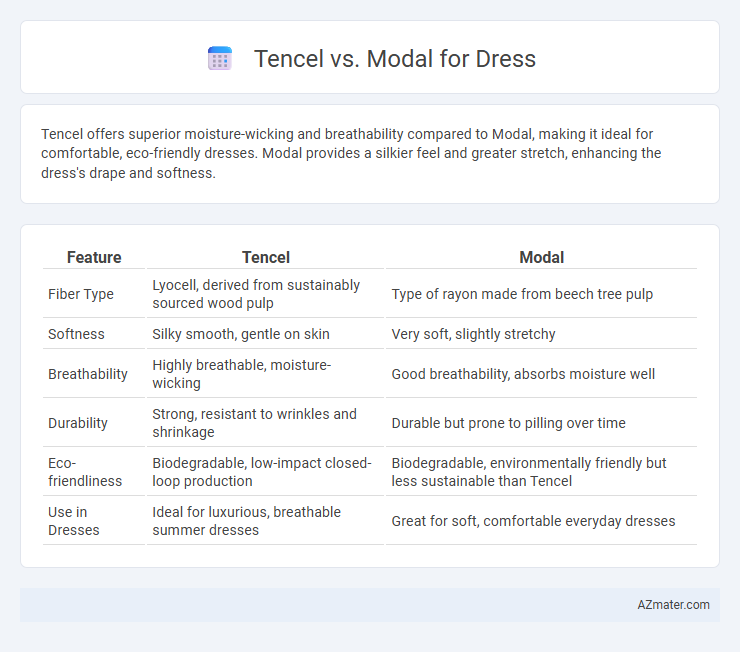Tencel offers superior moisture-wicking and breathability compared to Modal, making it ideal for comfortable, eco-friendly dresses. Modal provides a silkier feel and greater stretch, enhancing the dress's drape and softness.
Table of Comparison
| Feature | Tencel | Modal |
|---|---|---|
| Fiber Type | Lyocell, derived from sustainably sourced wood pulp | Type of rayon made from beech tree pulp |
| Softness | Silky smooth, gentle on skin | Very soft, slightly stretchy |
| Breathability | Highly breathable, moisture-wicking | Good breathability, absorbs moisture well |
| Durability | Strong, resistant to wrinkles and shrinkage | Durable but prone to pilling over time |
| Eco-friendliness | Biodegradable, low-impact closed-loop production | Biodegradable, environmentally friendly but less sustainable than Tencel |
| Use in Dresses | Ideal for luxurious, breathable summer dresses | Great for soft, comfortable everyday dresses |
Introduction: Tencel vs Modal for Dress Fabrics
Tencel and Modal are both popular fabric choices for dressmaking due to their softness, breathability, and sustainable production processes. Tencel, derived from eucalyptus trees, offers excellent moisture-wicking properties and durability, making it ideal for active or all-day wear dresses. Modal, produced from beech tree pulp, is known for its silky texture and vibrant color retention, providing a luxurious feel and appearance suitable for elegant, flowing dresses.
What is Tencel?
Tencel is a brand name for lyocell, a sustainable fabric made from eucalyptus tree fibers using an environmentally friendly closed-loop process that recycles water and solvents. It offers excellent breathability, moisture-wicking properties, and a smooth, silk-like texture, making it ideal for dresses that require comfort and elegance. Tencel fibers are biodegradable and hypoallergenic, enhancing the eco-conscious appeal of garments crafted from this material.
What is Modal?
Modal is a semi-synthetic fabric derived from beech tree pulp, known for its softness, breathability, and excellent moisture-wicking properties. It offers a smooth texture and drapes well, making it a popular choice for dresses that require comfort and a luxurious feel. Compared to Tencel, Modal is more resistant to shrinkage and retains color vibrancy longer, enhancing the durability and appearance of dresses.
Tencel vs Modal: Fabric Composition
Tencel fabric is made from sustainably sourced wood pulp, primarily eucalyptus trees, using a closed-loop process that recycles water and solvents, resulting in a soft, breathable, and biodegradable material ideal for dresses. Modal is a type of rayon derived from beech tree pulp, known for its silky texture, high moisture absorbency, and durability, but its production often involves more chemicals compared to Tencel. Dresses made from Tencel offer superior environmental benefits and moisture management, while modal dresses provide exceptional softness and resistance to shrinkage.
Comfort and Feel: Comparing Tencel and Modal Dresses
Tencel dresses offer exceptional moisture-wicking properties and a smooth, breathable texture, making them ideal for all-day comfort and temperature regulation. Modal dresses provide a soft, silky feel with excellent drape and stretch, enhancing ease of movement and a luxurious touch against the skin. Both fabrics boast eco-friendly credentials, but Tencel often feels cooler and more breathable, while Modal stands out for its rich softness and durability.
Breathability and Moisture-Wicking Properties
Tencel fabric, derived from sustainably sourced eucalyptus fibers, offers superior breathability and excellent moisture-wicking properties, making it ideal for dresses worn in warm climates. Modal, a semi-synthetic fabric made from beech tree pulp, also provides good breathability but tends to retain more moisture compared to Tencel, which can impact comfort during prolonged wear. For dresses requiring maximum comfort with efficient sweat absorption and quick drying, Tencel outperforms Modal due to its enhanced airflow and moisture management capabilities.
Durability and Longevity in Dresses
Tencel fabric offers exceptional durability and maintains its strength even after multiple washes, making it ideal for long-lasting dresses that retain their shape and softness. Modal is also durable but tends to pill and lose its shape faster over time, especially with frequent wear. For dresses requiring sustained longevity and resistance to wear, Tencel outperforms Modal in maintaining fabric integrity and appearance.
Eco-Friendliness: Sustainable Fashion Choices
Tencel and Modal are both eco-friendly fabrics derived from renewable wood sources, with Tencel made from eucalyptus trees using a closed-loop process that recycles water and solvents, minimizing environmental impact. Modal, produced from beech trees, is also biodegradable and biodegradable and often made using sustainable forestry practices but typically involves more water and chemicals during manufacturing. Choosing Tencel for dresses supports sustainable fashion due to its lower carbon footprint and reduced resource consumption compared to Modal.
Care and Maintenance Differences
Tencel dresses require gentle washing with mild detergents and should be air-dried to maintain fabric strength and prevent shrinkage. Modal dresses are more resilient to frequent washing and can often tolerate machine washing on a delicate cycle, but high heat drying should be avoided to prevent fabric damage. Both fibers benefit from low-heat ironing, though Tencel's moisture-wicking properties reduce the need for extensive maintenance compared to Modal.
Which is Better: Tencel or Modal for Dresses?
Tencel and Modal are both sustainable fabrics derived from wood pulp, but Tencel offers superior breathability and moisture-wicking properties, making it ideal for dresses worn in warmer climates or active settings. Modal provides a silky-smooth texture with excellent drape and durability, perfect for dresses requiring a soft, luxurious feel that resists shrinking and fading. For eco-conscious consumers seeking comfort and performance, Tencel is often better for casual or summer dresses, while Modal excels in elegant, form-fitting designs.

Infographic: Tencel vs Modal for Dress
 azmater.com
azmater.com